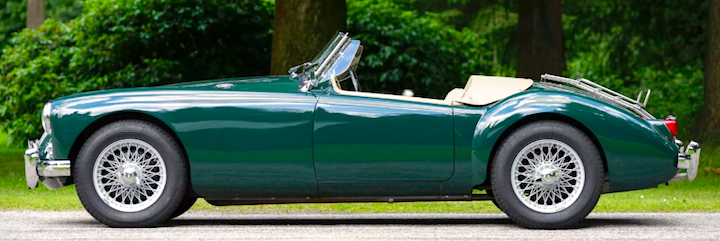Whereas TCs were rather spindly looking, the TDs seemed more substantial. They too eventually needed modernization, so the TF, which I wrote about here, was introduced. There was a limit to how many model years prewar styling would be viable in the American market, even for a sports car. So for 1955 the redesigned MGA was introduced. I posted about it here. The A received a new frame along with the new body, but its wheelbase was the same as the T-series MG just mentioned -- 94 inches (2,388 mm).
The MGA proved to be a short-lived transitional model. It was replaced by the MGB, a considerably modernized design using a unit-body instead of body-and-frame construction. Its wheelbase was slightly shorter at 91 inches (2,312 mm). Its length was 153 inches (3,886 mm), again shorter than the MGA at 156 inches (3,962 mm), whereas the older TF was 147 inches (3,734 mm) long.
The MGB was long-lived, versions remaining in production as late as 1980. However, it was long out of date stylistically and engineering-wise by that time.
The images below feature an early B from 1963 that was advertised for sale. A few photos of previous MGs are included for context.
The MG TF, last of the old breed. Go to the TF link above for a discussion of its styling.
Factory photo of the MGA. Its styling was in line with sports car fashions of the early '50s.
And this is the MGB. No more distinct rear fenders. More of a panoramic windshield. The traditional MG grille design is now strongly horizontal. Headlights are inset slightly from the front of the car in contrast to the protruding ones on the MGA. All-in-all, frontal styling is good, although the long chrome strip on the side of the car awkwardly extends too far forward. I award demerits for its touching of the headlight rim and the front wheel opening. Better it should have terminated about a third of the way between the opening and the leading door cut line.
Again, consider the position of the side strip. If it were shortened, its leading section should also be lowered a little, making it truly horizontal.
Side-view comparison with an MGA. The driver's seating position has been moved forward a bit, a good thing. This also allows more trunk room, making the car more practical.
To my way of thinking, the rear of the car is its greatest styling weakness. The fender line becomes rather boring by that point -- a slight bump in its profile would add interest. The vertical tail light ensembles give the rear a slightly pinched appearance. I would terminate them at about the level of the trunk lid cut line. These tail lights were also used on the new MG Midget announced in the summer of 1961, and were used on both cars as an economy measure.








1 comment:
I think that the MGB tail lights were also later used on the Austin 1100/Austin America. Among other things the constantly morphing British Motors/Leyland/Whatever was rather thrifty. The central speedo on Minis, repeated in every modern Mini even if it makes no sense, was so they didn't have to make two dashboards for UK and other countries.
Post a Comment